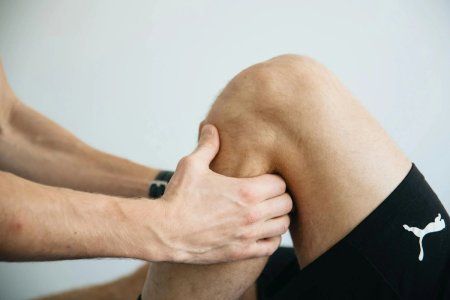Struggling with knee pain? The surprising connection you might be overlooking
By
Veronica E.
- Replies 0
Disclaimer: The information provided in this article is for educational purposes only and is not intended as a substitute for professional medical advice, diagnosis, or treatment. Always consult your physician or other qualified healthcare providers with any questions you may have regarding a medical condition or before making any changes to your health regimen.
Aches and pains can make even the simplest activities feel like a challenge—especially when it comes to our knees.
When discomfort strikes, it’s easy to assume the problem lies right where the pain is.
But sometimes, the real source of trouble is hidden elsewhere. If you’ve been trying to manage stubborn knee pain without much success, it might be time to shift your focus a little higher up the body.
While the knees often get all the attention, the hips play a crucial role in how our legs move and function.
The hips are ball-and-socket joints designed for a wide range of motion, while the knees act more like hinges, bending and straightening with each step.
When hip mobility or strength is limited, it can throw off the natural mechanics of the legs, placing extra strain on the knees.
Over time, this imbalance can lead to chronic discomfort—or even serious conditions like patellofemoral pain syndrome or osteoarthritis.

Today’s lifestyle habits, especially long hours spent sitting, can cause tightness in the hip flexors and weakness in the glute muscles.
These imbalances restrict how well the hips move, affecting pelvic alignment and the overall stability of the lower body.
Even seniors who stay active with activities like gardening, walking, or swimming can unknowingly reinforce poor hip movement patterns if they skip regular mobility exercises.
Not sure if your hips are involved?
Common clues include knee pain after sitting for long periods, soreness when climbing stairs, or discomfort during certain stretches targeting the hips.
You might also notice your knees caving inward during movements like squats or lunges—another sign that hip stability needs attention.
If you’re experiencing any of these symptoms, it’s a good idea to consult with a healthcare professional, such as a physical therapist, to get personalized advice and ensure you’re approaching your recovery safely.
Want to help your knees feel better? Here are five strategies that focus on strengthening and improving mobility in the hips:
1. Release your hip flexors
Tight hip flexors can pull the pelvis out of alignment, adding extra pressure on the knees. Gentle hip flexor releases from multiple angles can ease tension and improve flexibility.
2. Strengthen your inner hips and legs
Weak adductors and glutes can disrupt leg alignment. Exercises like the modified glute bridge can help stabilize these muscles, reducing lateral knee strain.
3. Incorporate lateral lunges
Side-to-side movements, like lateral lunges, build strength and control across the hips—essential for keeping knees properly supported during daily activities.
4. Use soft-tissue techniques
Foam rolling or using a massage gun before stretching can improve muscle tissue quality, making your mobility exercises more effective.
5. Stretch smart
Instead of deep or extreme stretches that can stress the knees, try supported stretches like the seated figure-four or a modified pigeon stretch on a chair or couch.
Knee pain can disrupt daily life, but the solution often lies not in the knees themselves—but in the hips.
Improving hip flexibility, strength, and control can take pressure off the knees and help you move more comfortably.
By taking a few proactive steps to care for your hips, you may not only reduce knee pain but also enhance your overall quality of life.
Read next: Another danger of ultra-processed food: The bone disease link

Have you tried exercises to help with knee or hip pain? What has helped you the most in staying active and comfortable? Share your experiences with us in the comments—we always enjoy hearing from you!
Aches and pains can make even the simplest activities feel like a challenge—especially when it comes to our knees.
When discomfort strikes, it’s easy to assume the problem lies right where the pain is.
But sometimes, the real source of trouble is hidden elsewhere. If you’ve been trying to manage stubborn knee pain without much success, it might be time to shift your focus a little higher up the body.
While the knees often get all the attention, the hips play a crucial role in how our legs move and function.
The hips are ball-and-socket joints designed for a wide range of motion, while the knees act more like hinges, bending and straightening with each step.
When hip mobility or strength is limited, it can throw off the natural mechanics of the legs, placing extra strain on the knees.
Over time, this imbalance can lead to chronic discomfort—or even serious conditions like patellofemoral pain syndrome or osteoarthritis.

Sometimes where we feel the pain isn’t where the problem starts—taking care of joint health can make all the difference. Image Source: Pexels / Funkcinės Terapijos. Centras.
How lifestyle habits can affect your hips—and your knees
Today’s lifestyle habits, especially long hours spent sitting, can cause tightness in the hip flexors and weakness in the glute muscles.
These imbalances restrict how well the hips move, affecting pelvic alignment and the overall stability of the lower body.
Even seniors who stay active with activities like gardening, walking, or swimming can unknowingly reinforce poor hip movement patterns if they skip regular mobility exercises.
Signs your hips might be contributing to knee pain
Not sure if your hips are involved?
Common clues include knee pain after sitting for long periods, soreness when climbing stairs, or discomfort during certain stretches targeting the hips.
You might also notice your knees caving inward during movements like squats or lunges—another sign that hip stability needs attention.
If you’re experiencing any of these symptoms, it’s a good idea to consult with a healthcare professional, such as a physical therapist, to get personalized advice and ensure you’re approaching your recovery safely.
Also read: Can you reverse osteoporosis? The surprising truth about stronger bones after 60
Five ways to improve hip mobility and support knee health
Want to help your knees feel better? Here are five strategies that focus on strengthening and improving mobility in the hips:
1. Release your hip flexors
Tight hip flexors can pull the pelvis out of alignment, adding extra pressure on the knees. Gentle hip flexor releases from multiple angles can ease tension and improve flexibility.
2. Strengthen your inner hips and legs
Weak adductors and glutes can disrupt leg alignment. Exercises like the modified glute bridge can help stabilize these muscles, reducing lateral knee strain.
Also read: Over 50? The secret to stronger knees starts here!
3. Incorporate lateral lunges
Side-to-side movements, like lateral lunges, build strength and control across the hips—essential for keeping knees properly supported during daily activities.
4. Use soft-tissue techniques
Foam rolling or using a massage gun before stretching can improve muscle tissue quality, making your mobility exercises more effective.
5. Stretch smart
Instead of deep or extreme stretches that can stress the knees, try supported stretches like the seated figure-four or a modified pigeon stretch on a chair or couch.
Knee pain can disrupt daily life, but the solution often lies not in the knees themselves—but in the hips.
Improving hip flexibility, strength, and control can take pressure off the knees and help you move more comfortably.
By taking a few proactive steps to care for your hips, you may not only reduce knee pain but also enhance your overall quality of life.
Read next: Another danger of ultra-processed food: The bone disease link
Key Takeaways
- Knee pain can often be attributed to tight hips, which lead to changes in leg movement and added stress on the knees.
- Lifestyle and movement habits, such as prolonged sitting and repetitive motions, can cause tight hip flexors and weak glutes, affecting hip and knee alignment.
- Signs of hip-related knee pain may include discomfort after sitting, pain when climbing stairs, or soreness during hip stretches, as well as issues with balance or inner thigh and glute strength.
- Strategies to relieve knee pain include exercises to release hip flexors, strengthening inner leg muscles for better alignment, practicing controlled lateral lunges for functional hip mobility, and using soft-tissue techniques and well-balanced stretches to restore hip motion.
Have you tried exercises to help with knee or hip pain? What has helped you the most in staying active and comfortable? Share your experiences with us in the comments—we always enjoy hearing from you!






